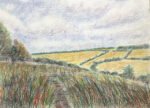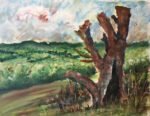Just the one oil pastel piece today. When I was out exploring Queendown Warren the…

Yaugher Lane, Queendown Warren
We’re getting close to that time of year when the oil pastels start melting in my hands and become unusable so, with today being a lot colder than yesterday, I seized what might be my last chance for months to give them a runout.
For subject matter I punched a view looking down Yaugher Lane where it goes through Queendown Warren. This hill is one I walk down on what’s by far the most regular circuit I take on my daily walks. I was drawn in by the one point perspective, the light area at the vanishing point and the tree on the right. My oil pastel set has a lot of greens in it, having been put together by Sennelier for landscape artists rather than figure or portrait artists and I thought I’d let the greens do most of the work today, something I rarely do. In fact my most green paintings have tended to be portraits.
For most of my oil pastel paintings, I tend to fill areas with lots of different colours and then smooth them together with my fingers or with tools. Today, though, I only really did that for the road. It took several layers of colours for me to get it right, probably because it took me a while to work out that smoothing it with a finger along lines radiating from the vanishing point worked better than smoothing from left to right. My excuse is that left to right strokes would probably be the way to go for watercolour.
For the leaves in the trees, and to a lesser extent the leaves on the road, I gave it the full Van Gogh and just stabbed in loads of colours and didn’t smooth them. In the trees I started from the darkest greens, gradually getting lighter and finishing at yellow, trying to have the lightest colours on the top of the leafy clumps. After that I stabbed in some random bits with red deep and delft blue, my favourite two oil pastel colours. I left gaps in places to show the blue sky behind the leaves but later stabbed white into the sky holes to match the van Gogh style in the leaves. I adopted a similar approach to the leaves on the road but with more autumnal colours and less green.
For the starting trees on the right, I put in all sorts of colours, then smoothed them out with a rubber tool, moving quickly backwards and forwards from left to right and slowly along the tree, to create the feeling of a long cylinder. I did something similar for the fenceposts, albeit without so many colours. And I scraped out some wires between the posts with a craft knife.
And then there were the rest of the trees and the branches. I started by just drawing these in, first with some dark browns and later with other colours like reds, blues and greens. I might even have scraped out the odd twig or branch with the craft knife. Things looked OK but I couldn’t resist tinkering and, for once, the tinkering was a huge success and revealed to me a great new technique. First, I went over all those monotone trees and branches with the rubber tool on a stick, again moving slowly along the branches but quickly side to side to create cylindrical shapes. It worked brilliantly. I could have stopped there but I thought I’d try something else new. I went for the side to side cylinder creation manouver again but this time I did it over the leaves without drawing a branch in first. So I was mixing together all the leaf colours and creating branches from nothing. And this worked even better. An amazing discovery. And that was me done.
I’m happy with this one. There’s a lot to like about it and I think it will be popular. It’s up for sale. To see the price, click here.








Leave a Reply